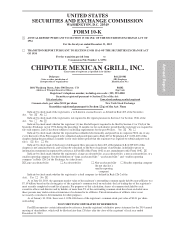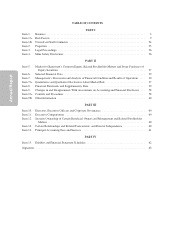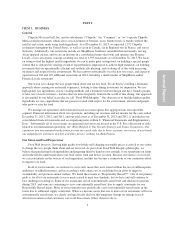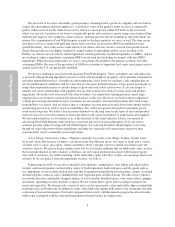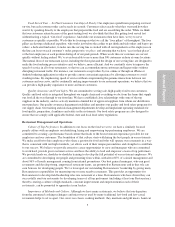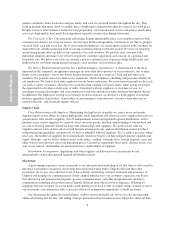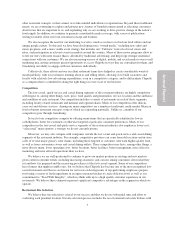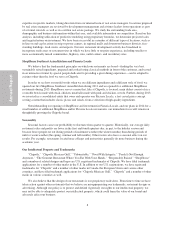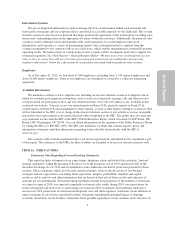Chipotle 2013 Annual Report Download - page 8
Download and view the complete annual report
Please find page 8 of the 2013 Chipotle annual report below. You can navigate through the pages in the report by either clicking on the pages listed below, or by using the keyword search tool below to find specific information within the annual report.
produce and herbs, make fresh salsa and guacamole, and cook rice in small batches throughout the day. They
work in kitchens that more closely resemble those of high-end restaurants than they do a typical fast-food place.
Despite our more labor-intensive method of food preparation, our focused menu creates efficiencies which allow
us to serve high quality food made from ingredients typically found in fine dining restaurants.
The Front Line is Key. Our restaurant and kitchen designs intentionally place crew members up front with
customers to reinforce our focus on service, and our open kitchen design allows customers to see that we prepare
our food fresh, each and every day. All of our restaurant employees are encouraged to interact with customers no
matter their job, whether preparing food or serving customers during our busiest period. We focus on attracting
and retaining people who can deliver that experience for each customer. We provide each customer with
individual attention and make every effort to respond to customer suggestions and concerns in a personal and
hospitable way. We believe our focus on creating a positive and interactive experience helps build loyalty and
enthusiasm for our brand among general managers, crew members and customers alike.
The Basics. Each restaurant typically has a general manager (a position we’ve characterized as the most
important in the company), an apprentice manager (in more than three-quarters of our restaurants), one to three
hourly service managers, one or two hourly kitchen managers and an average of 23 full and part-time crew
members. We generally have two shifts at our restaurants, which simplifies scheduling and provides stability for
our employees. We tend to have more employees in our busier restaurants. We cross-train our people so that each
can work a variety of stations, allowing us to work efficiently during our busiest times, while giving our people
the opportunity to develop a wider array of skills. Consistent with our emphasis on customer service, we
encourage our general managers and crew members to welcome and interact with customers throughout the day.
In addition to the employees serving our customers at each restaurant, we also have a field support system that
includes apprentice team leaders, team leaders or area managers, team directors, executive team directors or
regional directors, and restaurant support officers.
Supply Chain
Close Relationships with Suppliers. Maintaining the high levels of quality we expect in our restaurants
depends in part on our ability to acquire high-quality, fresh ingredients and other necessary supplies that meet our
specifications from reliable suppliers. Our 23 independently owned and operated regional distribution centers
purchase from various suppliers we carefully select based on quality and their understanding of our mission, and
we seek to develop mutually beneficial long-term relationships with suppliers. We work closely with our
suppliers and use a mix of forward, fixed and formula pricing protocols, and our distribution centers purchase
within the pricing guidelines and protocols we have established with the suppliers. We’ve tried to increase, where
necessary, the number of suppliers for our ingredients, which we believe can help mitigate pricing volatility and
supply shortages, and we follow industry news, trade issues, weather, exchange rates, foreign demand, crises and
other world events that may affect our ingredient prices. Certain key ingredients (beef, pork, chicken, beans, rice,
sour cream, cheese, and tortillas) are purchased from a small number of suppliers.
Distribution Arrangements. Ingredients and other supplies are delivered to our restaurants by our
independently owned and operated regional distribution centers.
Marketing
A great dining experience in our restaurants is our most powerful marketing of all. But there is still a need to
introduce our brand to consumers, and to help them understand what makes Chipotle different than other
restaurants. So we pay close attention to all of these details, monitoring customer sentiment and awareness of
Chipotle and keeping our communications closely aligned with the ways our customers experience our brand.
Our advertising and promotional programs, in-store communications, and other design elements all help to
communicate something about what makes Chipotle different from other fast food companies. Whether it’s
engaging with our company via social media, participating in our local events or simply eating a burrito at one of
our restaurants, each interaction with a customer affords us an important opportunity to build our brand.
Our advertising has generally included print, outdoor, transit and radio ads, but we are also incorporating
online advertising into the mix, and adding strategic promotions that demonstrate how Chipotle is different than
6
Annual Report



